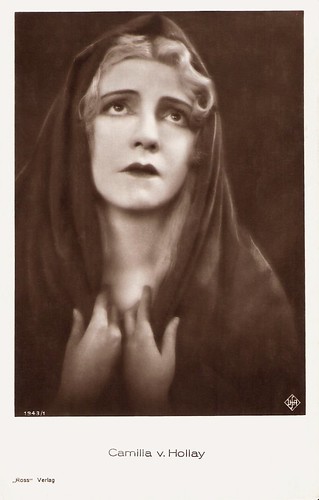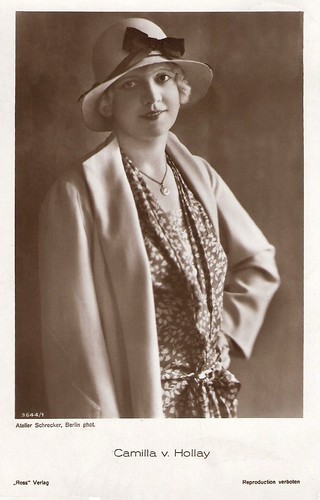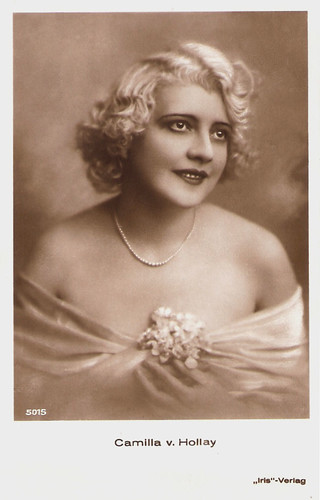Camilla von Hollay (1894–1967) was a Hungarian film actress of the silent era. She appeared in more than 40 films between 1916 and 1930, first in Hungary and later in Germany.

Bulgarian postcard by gr Paskob, Sofia, 1929. Photo: publicity still for Überflüssige Menschen/Superfluous People (Aleksandr Razumnyj, 1926).

German postcard by Ross Verlag, no. 1943/1, 1927-1928. Photo: Ufa.
Camilla von Hollay was born Kamillá Borbála Hollay in Budapest, Austria-Hungary (now Hungary) in 1894 (some sources say 1899). Her parents were the industrialist Adalbert 'Béla' Hollay and his wife Borbála Weigert. They wanted her to study medicine after finishing school.
However, against her parents' will she attended Szidi Rákosi's drama school in 1915. She began her career in Székesfehérvár in the company of Lajos Szalkai. She also played ingenue roles in Szeged in Endre Almássy's company and in Békésgyula. Later she was engaged by the Buda Theatre Circle in Budapest.
For two years she played at the Vígszínház, The Comedy Theatre of Budapest, in plays like 'Az ördög' (The Devil) and 'Liliom' by Ferenc Molnár and 'Pygmalion' by George Bernard Shaw. In June 1918, she appeared for the last time at the Comedy Theatre of Budapest.
According to German Wikipedia, her film debut was already in 1913 in an unknown Hungarian silent film. From 1916 on she started to appear regularly in the cinema billed as Kamilla Hollai. Her first and second films were Jenő Illés' silent film János Vitéz (1916) and Mire megvénülünk/What is Shallow (Ödön Uher jr., 1916). Film historians refer to her as one of the first female film stars of the Hungarian silent film industry, because János Vitéze with Kamilla Hollai as the female lead was one of the first full-length Hungarian silent films.
In the films A régiséggyütjö/The Antiquarian (Alfréd Deésy, 1917), Casanova (Alfréd Deésy, 1918) and the Oscar Wilde adaptation Az élet kiralya/The Picture of Dorian Gray (Alfréd Deésy, 1918), she appeared at the side of Arisztid Olt. Olt would later become known as Hollywood icon Béla Lugosi thanks to his legendary role as Count Dracula. In 1920, she was hired by the Corvin Film Factory, but later she founded her own studio. She was the first actress to be hired by a Hungarian film company for a year rather than a film. After many successes, she left the country during the difficult economic situation after World War I. She went to the centre of Cinema Europe, Berlin.

Hungarian postcard by the magazine Shinhazi Elet (Theatre Life), no. 109. Photo: Angelo / City.

Hungarian postcard by the magazine Shinhazi Elet (Theatre Life), no. 111. Photo: Angelo, Budapest, 1918 / City.
In 1922, Kamillá Hollai went to Berlin to take over the lead in Das Feuerschiff/The Fire Ship (Richard Löwenbein, 1922). In Germany, she changed her name to Camilla von Hollay.
During the 1920s she starred in such German films as Ein Traum vom Glück/A Dream of Happiness (Paul L. Stein, 1924) with Harry Liedtke, Die Wiskottens (Arthur Bergen, 1926), Madame wünscht keine Kinder/Madame Doesn't Want Children (Alexander Korda, 1927). In 1927 Camilla von Hollay was signed by Berlin's Phoebus Film, but she also played stage roles.
Camilla von Hollay acted in such German films as the Asta Nielsen vehicle Gehetzte Frauen/Agitated Women (Richard Oswald, 1927), Die Weber/The Weavers (Friedrich Zelnik, 1927) with Paul Wegener, and Waterloo (Karl Grune, 1928) starring Charles Vanel.
The sound film didn't offer her demanding roles - probably because of her Hungarian accent, suggests Thomas Staedeli at Cyranos. She only acted in minor roles in films like Die zärtlichen Verwandten/Beloved Family (Richard Oswald, 1930) and Tingel-Tangel (Jaap Speyer, 1931) featuring Ernö Verebes. In 1924 she married the Hungarian journalist and author Jenő Szatmári in Berlin. After several years in Berlin, she and her husband returned to Budapest in the 1930s.
Camilla von Hollay no longer took acting roles, but she remained active in the theatre scene. During the 1930s, she wrote plays and film scripts. In 1952, she was relocated to a farmhouse in Hajdúnánás. Her health deteriorated and she spent nine months in a clinic in Debrecen. Jenő Szatmári died in 1953. In the same year, Hollay was allowed to return to Budapest, but with no relatives, she was only able to find a place in a social home in Soroksár. From there, she was placed in an actors' home in 1954. Camilla von Hollay died in Budapest in 1967. She was 72.

German postcard by Ross Verlag, no. 3644/1, 1928-1929. Photo: Atelier Schrecker, Berlin.

Austrian postcard by Iris-Verlag, no. 5015.

German postcard by Verlag Hermann Leiser, Berlin-Wilm., no. 6445, Photo: Atelier Jacobi, Berlin, Charlottenburg.
Sources: Thomas Staedeli (Cyranos), Hungarian movie database (Hungarian - now defunct), Wikipedia (Hungarian, Engels and German), and IMDb.
This post was last updated on 14 October 2024.

Bulgarian postcard by gr Paskob, Sofia, 1929. Photo: publicity still for Überflüssige Menschen/Superfluous People (Aleksandr Razumnyj, 1926).

German postcard by Ross Verlag, no. 1943/1, 1927-1928. Photo: Ufa.
Count Dracula
Camilla von Hollay was born Kamillá Borbála Hollay in Budapest, Austria-Hungary (now Hungary) in 1894 (some sources say 1899). Her parents were the industrialist Adalbert 'Béla' Hollay and his wife Borbála Weigert. They wanted her to study medicine after finishing school.
However, against her parents' will she attended Szidi Rákosi's drama school in 1915. She began her career in Székesfehérvár in the company of Lajos Szalkai. She also played ingenue roles in Szeged in Endre Almássy's company and in Békésgyula. Later she was engaged by the Buda Theatre Circle in Budapest.
For two years she played at the Vígszínház, The Comedy Theatre of Budapest, in plays like 'Az ördög' (The Devil) and 'Liliom' by Ferenc Molnár and 'Pygmalion' by George Bernard Shaw. In June 1918, she appeared for the last time at the Comedy Theatre of Budapest.
According to German Wikipedia, her film debut was already in 1913 in an unknown Hungarian silent film. From 1916 on she started to appear regularly in the cinema billed as Kamilla Hollai. Her first and second films were Jenő Illés' silent film János Vitéz (1916) and Mire megvénülünk/What is Shallow (Ödön Uher jr., 1916). Film historians refer to her as one of the first female film stars of the Hungarian silent film industry, because János Vitéze with Kamilla Hollai as the female lead was one of the first full-length Hungarian silent films.
In the films A régiséggyütjö/The Antiquarian (Alfréd Deésy, 1917), Casanova (Alfréd Deésy, 1918) and the Oscar Wilde adaptation Az élet kiralya/The Picture of Dorian Gray (Alfréd Deésy, 1918), she appeared at the side of Arisztid Olt. Olt would later become known as Hollywood icon Béla Lugosi thanks to his legendary role as Count Dracula. In 1920, she was hired by the Corvin Film Factory, but later she founded her own studio. She was the first actress to be hired by a Hungarian film company for a year rather than a film. After many successes, she left the country during the difficult economic situation after World War I. She went to the centre of Cinema Europe, Berlin.

Hungarian postcard by the magazine Shinhazi Elet (Theatre Life), no. 109. Photo: Angelo / City.

Hungarian postcard by the magazine Shinhazi Elet (Theatre Life), no. 111. Photo: Angelo, Budapest, 1918 / City.
Berlin
In 1922, Kamillá Hollai went to Berlin to take over the lead in Das Feuerschiff/The Fire Ship (Richard Löwenbein, 1922). In Germany, she changed her name to Camilla von Hollay.
During the 1920s she starred in such German films as Ein Traum vom Glück/A Dream of Happiness (Paul L. Stein, 1924) with Harry Liedtke, Die Wiskottens (Arthur Bergen, 1926), Madame wünscht keine Kinder/Madame Doesn't Want Children (Alexander Korda, 1927). In 1927 Camilla von Hollay was signed by Berlin's Phoebus Film, but she also played stage roles.
Camilla von Hollay acted in such German films as the Asta Nielsen vehicle Gehetzte Frauen/Agitated Women (Richard Oswald, 1927), Die Weber/The Weavers (Friedrich Zelnik, 1927) with Paul Wegener, and Waterloo (Karl Grune, 1928) starring Charles Vanel.
The sound film didn't offer her demanding roles - probably because of her Hungarian accent, suggests Thomas Staedeli at Cyranos. She only acted in minor roles in films like Die zärtlichen Verwandten/Beloved Family (Richard Oswald, 1930) and Tingel-Tangel (Jaap Speyer, 1931) featuring Ernö Verebes. In 1924 she married the Hungarian journalist and author Jenő Szatmári in Berlin. After several years in Berlin, she and her husband returned to Budapest in the 1930s.
Camilla von Hollay no longer took acting roles, but she remained active in the theatre scene. During the 1930s, she wrote plays and film scripts. In 1952, she was relocated to a farmhouse in Hajdúnánás. Her health deteriorated and she spent nine months in a clinic in Debrecen. Jenő Szatmári died in 1953. In the same year, Hollay was allowed to return to Budapest, but with no relatives, she was only able to find a place in a social home in Soroksár. From there, she was placed in an actors' home in 1954. Camilla von Hollay died in Budapest in 1967. She was 72.

German postcard by Ross Verlag, no. 3644/1, 1928-1929. Photo: Atelier Schrecker, Berlin.

Austrian postcard by Iris-Verlag, no. 5015.

German postcard by Verlag Hermann Leiser, Berlin-Wilm., no. 6445, Photo: Atelier Jacobi, Berlin, Charlottenburg.
Sources: Thomas Staedeli (Cyranos), Hungarian movie database (Hungarian - now defunct), Wikipedia (Hungarian, Engels and German), and IMDb.
This post was last updated on 14 October 2024.
No comments:
Post a Comment